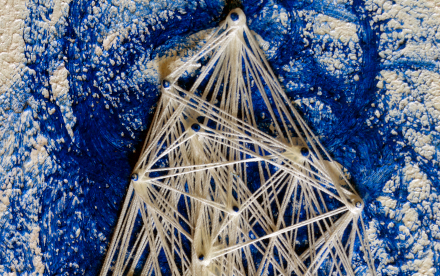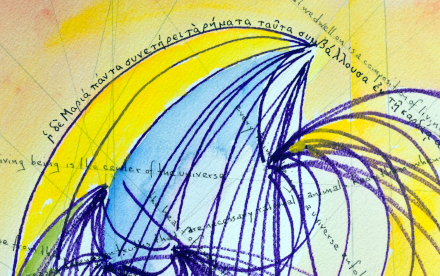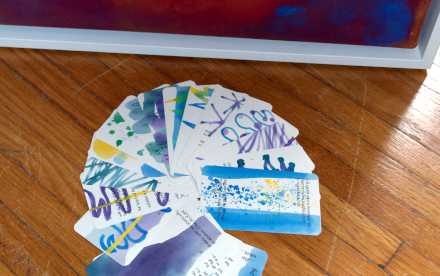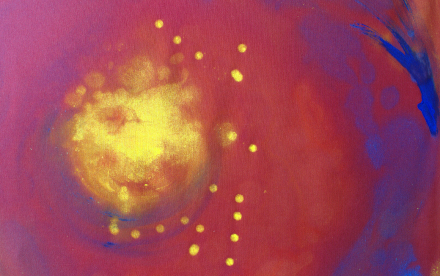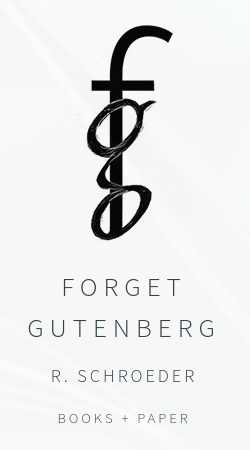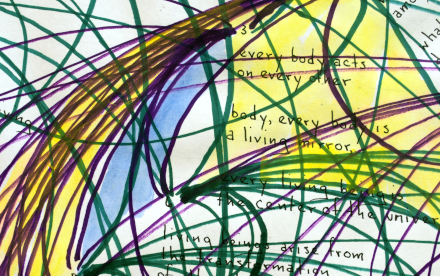
a note on process: the icons
1. "The beat of the sounding body 1" was done with watercolors and ink on bamboo paper. I spread the paper on the floor and cast 18 wood blocks the size of dice on the surface. I marked the location of each block and used those markings (numbered 1-18) to determine where to write the 18 poems (or 18 stanzas). The writing was done with a Faber-Castell India Ink pen, with the orientation determined more or less by the angle of each block. On top of the writing, I used markers to draw arcs connecting every stanza with every other stanza, odds to the left using a purple marker and evens to the right using green. I used watercolors to highlight a pattern that emerged at the intersection of those lines drawing on the tradition(s) of madonna and child icons. I find the description of what Maria/Miriam did (that I used as an epigraph in the printed poem) intriguing. She was an unwed mother, probably fifteen years old, probably scared to death (for good reason) about what people were going to think of her and do to her – and the writer says she put all the stuff that had happened to her in her heart and dwelt on it. I think that taking it all in and dwelling on it has a lot in common with Joyce's here comes everybody approach to the world.
2. "The beat of the sounding body 2" was done with acrylic on an old bamboo cutting board. I cast 18 wood blocks the size of dice on the surface of the cutting board and marked the location of each block. I drove a 3/4" wire brad into the block at each mark, then used a 2" brush to apply a white background and a 1" brush to connect every brad to every other brad with an arc of cobalt blue acrylic. Finally, I used white cotton thread to connect every brad with every other brad. This second variation does not include text but also draws on the tradition(s) of madonna and child icons. An image of this icon is on the back of the cards that make up "the beat of the sounding body 4," an oracle deck created by forgetgutenberg to accompany the icon.
3. "The beat of the sounding body 3" was done with watercolors and ink on 140 lb cold pressed watercolor paper. As with the first variation, I placed the paper on the floor and cast 18 wood blocks the size of dice on the surface. I marked the location of each block and used those markings (numbered 1-18) to determine where to write selections from the 18 poems (or 18 stanzas). The writing was done with a Faber-Castell India Ink pen, with the orientation determined by the angle of each block. (Lines corresponding to the top left and top right sides of each block were traced to the edge of the page with a graphite pencil. On top of the writing, I used a purple marker to draw arcs connecting every stanza with every other stanza. I used watercolors to highlight the pattern that emerged at the intersection of those arcs drawing on the tradition(s) of madonna and child icons. In this variation, I included the Greek text of the description (in the Gospel of Luke) of what Maria/Miriam did: she put all the stuff that had happened to her in her heart and dwelt on it.
4. "The beat of the sounding body 4" is an oracle deck of 21 cards created and printed by forgetgutenberg (Regina Schroeder) presenting a poem/translation by Steven Schroeder. (It is a limited edition of two.) The back of each card is an image of "the beat of the sounding body 2." Eighteen of the cards have one stanza of the poem on the front along with a digital watercolor wash by Regina Schroeder. One has a colophon, one has an epigraph (in Greek with English translation by Steven Schroeder) from the Gospel of Luke, and one is a title page. The font used for printing was designed by forgetgutenberg based on the poet's hand lettering on "the beat of the sounding body 1" and "the beat of the sounding body 3."
5. "The beat of the sounding body: yellow and blue dancers" is acrylic on fabric taken from the back of an old cotton shirt and stretched on a wooden frame. The title is from a meditation on Leibniz, "Principes de la nature et de la grâce fondés en raison":
music charms us
though its beauty
consists in nothing
but numbers
and the beat of the sounding body
